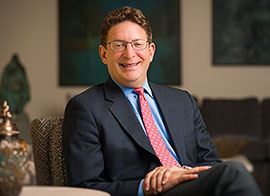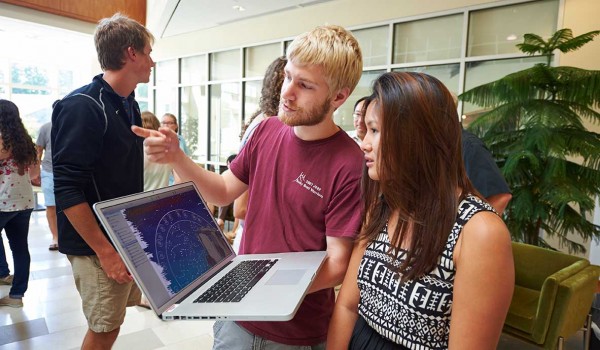
(Photo by Andrew Daddio)
Each morning, as I pass through the stunning new Hurwitz Admission Center in James B. Colgate Hall on the way up to my office, I am greeted by a parade of images and messages that illustrate how Colgate propels students into the world, both during their undergraduate experience, and afterward.
The transformed center, which opened in March, is one piece of our broader initiative to attract an academically impressive and more diverse population of highly qualified college-bound students. Through comprehensive research, we have learned much about how Colgate is perceived, most importantly in areas to where the college-bound population is shifting and Colgate is less well known, but also among our traditional pool of applicants. Our future admission marketing strategies will be informed by what we’ve learned.
James B.’s historic portrait still greets visitors to the center, but so does rich digital content that connects the academic work of our students to the inspiring success stories of graduates. The contemporary campus visit, framed under the theme, “Acres of countryside may surround us, but you have just arrived in the middle of everywhere” — and featuring the traditional post-tour Chipwich — is sure to resonate with our alumni as well.
More broadly, the changes to our admission program reflect the university’s ability to adapt and flourish in changing times.
As you may have read in a recent issue of ’Gateline or on the Colgate website, the Board of Trustees voted in January to approve our new strategic plan for 2014–2019, titled “Living the Liberal Arts in our Third Century.” Intended to address our most critical priorities and challenges, the plan identifies strategies under four key areas that will ensure that Colgate can be one of the world’s most vibrant liberal arts institutions.
You can read about the plan in more detail at www.colgate.edu/strategicplan, but I am pleased to share highlights here.
A need-blind admission policy
We must have a pipeline to the very best students in the United States and beyond. We aim to become “need-blind” — to admit the best-qualified students without respect to family finances. The approximately $141.5 million in financial aid raised during the Passion for the Climb campaign allowed for a significant increase in the number of aided students and contributed greatly to the record academic profile of the Class of 2017. Continuing to increase the resources available for financial aid will allow us to recruit even more outstanding students, reduce the pressure to recruit full-pay students, temper some concerns about tuition, and facilitate more applications from nontraditional areas. The Board of Trustees will determine when the appropriate circumstances exist for the university to implement a need-blind admission policy. Until then, every additional student who gains access to Colgate through financial aid is a victory.
A dynamic curriculum
We will continue to promote innovations in our liberal arts education model, in pedagogy, globalization, civic engagement, and technology. We must also pay more attention to teaching the skills that students will need throughout their lives, including the ability to think critically, write and listen well, and speak in public in a persuasive manner. Success in these areas is important to our students’ ability to participate as citizens and will make a Colgate education more compelling to prospective students.
A residential liberal arts education
It is no coincidence that this plan took its name from the “Living the Liberal Arts” strategic planning working group. We will enrich Colgate’s academically distinctive education by creating opportunities for research, internships, civic engagement, campus involvement, entrepreneurship, and technology. By leveraging the close relationship between teachers and learners, we will also address those aspects of student life that detract from the residential liberal arts vision to which Colgate aspires. We must enhance the environment for students of all backgrounds, facilitate interaction across groups, and create ways for an increasingly diverse student body to work together toward common goals.
A campus for Colgate’s third century
Colgate’s identity is inextricably tied to our beautiful campus; our master plan identifies three principles that will be critical to its evolution in the decades to come. First, we must develop a more compact campus. Approximately half of the student body lives on the other side of Broad Street, straining the natural connection between academic and social life. A significant number of student housing spaces must be brought up the Hill. Second, we need to enhance campus systems, especially providing a more pedestrian-friendly physical environment. Finally, we must ensure that our structures can better foster community.
As I attend Colgate events around the country and meet with alumni, parents, and friends, I look forward to hearing your reaction to this plan, and to updating you on our progress.

Jeffrey Herbst
16th President of Colgate University







